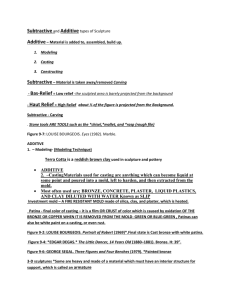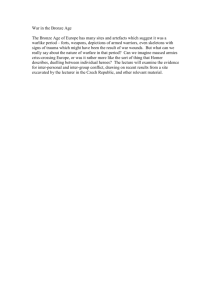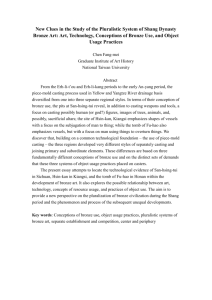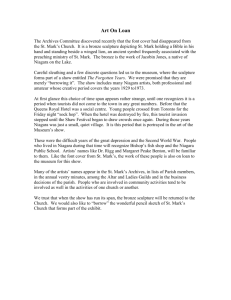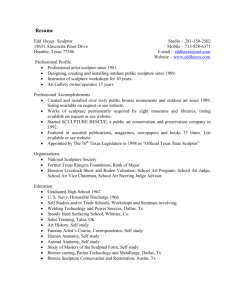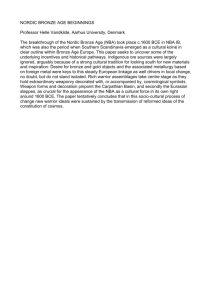Wiles, 1 A very readable background on the Renaissance sculptors
advertisement
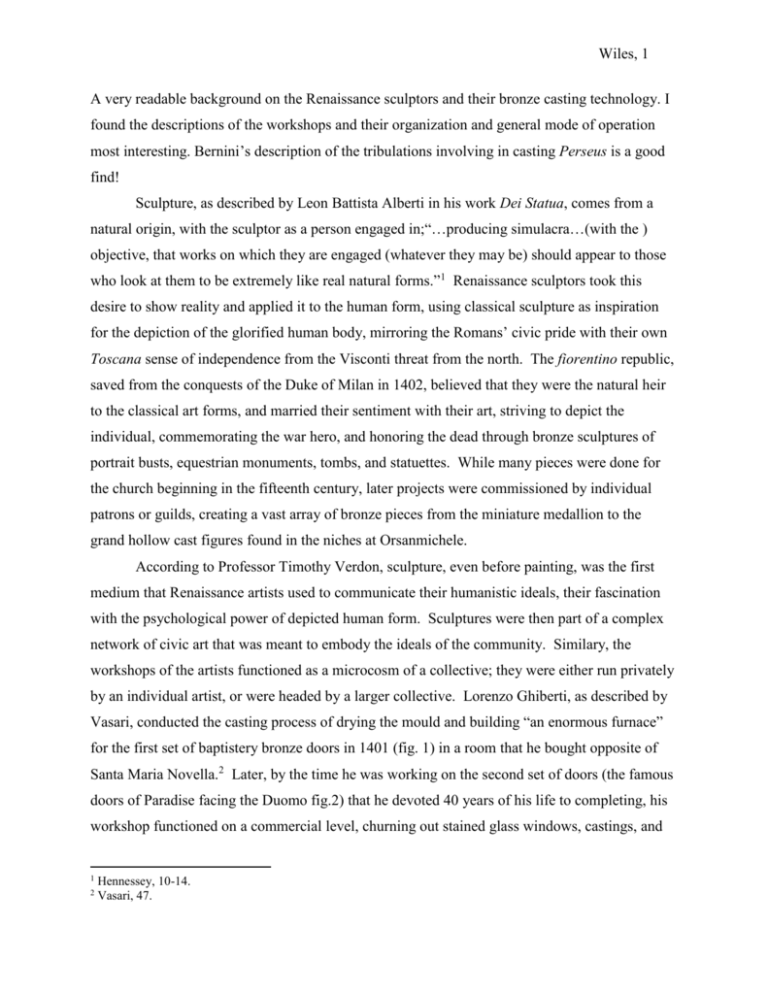
Wiles, 1 A very readable background on the Renaissance sculptors and their bronze casting technology. I found the descriptions of the workshops and their organization and general mode of operation most interesting. Bernini’s description of the tribulations involving in casting Perseus is a good find! Sculpture, as described by Leon Battista Alberti in his work Dei Statua, comes from a natural origin, with the sculptor as a person engaged in;“…producing simulacra…(with the ) objective, that works on which they are engaged (whatever they may be) should appear to those who look at them to be extremely like real natural forms.”1 Renaissance sculptors took this desire to show reality and applied it to the human form, using classical sculpture as inspiration for the depiction of the glorified human body, mirroring the Romans’ civic pride with their own Toscana sense of independence from the Visconti threat from the north. The fiorentino republic, saved from the conquests of the Duke of Milan in 1402, believed that they were the natural heir to the classical art forms, and married their sentiment with their art, striving to depict the individual, commemorating the war hero, and honoring the dead through bronze sculptures of portrait busts, equestrian monuments, tombs, and statuettes. While many pieces were done for the church beginning in the fifteenth century, later projects were commissioned by individual patrons or guilds, creating a vast array of bronze pieces from the miniature medallion to the grand hollow cast figures found in the niches at Orsanmichele. According to Professor Timothy Verdon, sculpture, even before painting, was the first medium that Renaissance artists used to communicate their humanistic ideals, their fascination with the psychological power of depicted human form. Sculptures were then part of a complex network of civic art that was meant to embody the ideals of the community. Similary, the workshops of the artists functioned as a microcosm of a collective; they were either run privately by an individual artist, or were headed by a larger collective. Lorenzo Ghiberti, as described by Vasari, conducted the casting process of drying the mould and building “an enormous furnace” for the first set of baptistery bronze doors in 1401 (fig. 1) in a room that he bought opposite of Santa Maria Novella.2 Later, by the time he was working on the second set of doors (the famous doors of Paradise facing the Duomo fig.2) that he devoted 40 years of his life to completing, his workshop functioned on a commercial level, churning out stained glass windows, castings, and 1 2 Hennessey, 10-14. Vasari, 47. Wiles, 2 enlisting the help of many young artists such as Brunelleschi and other gold smiths, Paolo Uccello, and Antonio del Pollaiuolo. As capomaestro, the artist headed projects and either directly hired assistants for, or, as in the case of guild-run workshops, recommended names of workers to the guild consuls. In the case of workshops run by larger companies, artists were supplied with materials, but were expected to pay their workers on an independent basis. For the actual bronze casting, artists either performed the precarious operations within the shop or hired outside sources such as bell and artillery manufacturers to handle the operation of melting the metal and creating the alloy directly in the furnace by mixing varying amounts of tin and copper.3 The process was not safe, nor was success guaranteed, Ghiberti failed on the first cast for his first doors as did many artists, therefore, only those patrons who had enough money to wager the possibility of failure commissioned trustworthy artists to manifest their company’s virtuosity in sculptural form. One of the best descriptions of the process, and the necessity of the artist to improvise, is described by the later 16th century artist Benvenuto Cellini in his Autobiography and Treatises which narrates the casting of his Perseus (1545-54 fig. 3), now in the Piazza della Signoria; I had made its clay tunic…enclosed it with iron supports, and began to draw off the wax by means of a slow fire…I built my Perseus a funnel-shaped furnace. It was built, that is, round the mould itself, and was made of bricks one on top of the other, with many gaps for the fire to escape…I at once began to dig the pit in which to bury it…I had had the furnace filled with a great many blocks of copper and other bronze scraps…I ordered the furnace to set alight…the workshop caught fire… later, during a second phase of the process: I found the metal all curdled…I ordered two of the hands to go…for a load of young oak that had been dried out a year or more before…it burns more fiercely than any other kind of wood that is slow burning and preferred for casting artillery…Then I had someone bring me a lump of pewter… seeing that the metal was not running as easily as it should…I sent for all my pewter plates, bowls, and salvers, which numbered about two hundred….throwing some straight into the furnace.4 Ghiberti, in addition to the two commissions from the arte della calimala for the bronze doors of the baptistery was also commissioned by the same guild to fill a niche in Orsanmichele with a bronze sculpture (the largest created in Florence thus far, 2.55 m tall with a 5mm shell 3 4 Paoletti, 35-36. Paoletti, 433. Wiles, 3 thickness) of their patron saint, St. John (fig. 4). Completed circa 1415, Ghiberti followed a markedly decorative visual scheme, akin to that of the International Gothic style from France that broke down the body and garments with a type of stylized realism characterized by elegance of line.5 He completed another two bronze of St. Matthew (fig. 5) and Stephen for the arte di cambio and the arte della Lana, both of which, like that of St.John were enormous, larger than life figures. As a younger contemporary of Ghiberti, Donatello was inspired by the scale of Ghiberti’s figures and created his own classically-based sculptural style that focused on utilizing the sheer size of the body to hang from it tremendous, voluminous, swelling drapery that gives his figures weight and power. As has been discussed, Donatello actually used hardened pieces of material in his original wax models so as to create a more realistic bronze cast to give his works a firmness of stance and expression.6 His classical principles, namely the power created by the stiffness of balanced form and adherence to realistic depictions, are also apparent in his Gattamelatta monument (1447-53 fig 6) in Padua, the first bronze equestrian monument completed since ancient Rome with the sculpture of emperor Marcus Aurelius which now remains at the campidoglio in Rome. Other famous casts of his that either adopt classical subject and form are the sensuous David (mid 1400s) and the violently beautiful Judith (1445), both commissioned by the Medici family (fig. 7, 8). Another of Donatello’s innovations in Bronze casting was his development of low relief, or sciacciato relievo that marries sculpture with the depiction of perspective, the movement of figure, and the creation of depth from two dimensional surfaces. His Pulpits in San Lorenzo (fig 9), considered his last unfinished masterpiece, are some of the best examples of this style of work continued by later artists, such as Bertoldo (fig. 10), student of Donatello and teacher of Michelangelo, in his classical composition of a battlescene. Towards the later half of the 15th century, Andrea del Verrocchio, teacher of Da Vinci, arose as the most prominent sculptor of the period, treating his figures with a delicateness of form and an emphasis on lyricism of linear form. Like Donatello, he created a large equestrian monument to a war hero (the casting was done by Alessandro Leopardi), Bartolomeo Colleoni (1479-96 also fig 6), commissioned by the Venitian Senate which displays a dynamism that 5 6 Krauftheimer, 44-54. Hennessey, 90. Wiles, 4 differs from the style of Donatello. A continuation of his style is seen at Orsanmichele with his sculpture of Christ and St. Thomas by the tribunal of the Mercanzia (fig. 11), which is perhaps the best example of his sensitivity to detail seen in the positions of the hands and the articulations of the feet.7 Vasari describes how Verocchio would study human forms by making moulds of hands, feet and other body parts from a soft stone native to Volterra that could be made into a ground and made into soft paste. He ironically died of a fever that he supposedly caught during a casting session, as was the fear of Cellini when he describes his process of casting for Perseus. Other artists who were markedly classical in their subject matter, who created works that incorporated the forms of Roman statuettes, are Pollajuolo and Riccio, namely Pollajuolo’s Hercules and Anteus (1470s fig. 12) commissioned by the Medicis and Riccio’s Paschal Candlelstick (fig. 13) . While the former is an interpretation of classical miniature statuettes, the latter is a functional object that incorporates statuettes as part of an overall decorative scheme.8 Cellini, as mentioned before, studied in Rome and worked for the French crown for some time before being commissioned by Cosimo dei Medici to make a bronze bust (of himself, naturally), and to make the Perseus in the beginning years of the 16th century. Both of these later works mark a movement of bronze sculpture that hearkens the movement from renaissance ideals to the subsequent high renaissance (and later maniera, and baroque periods) initiated in Rome with the further discovery of classical sculpture and the desire of the papacy to create monumental works as ways of visually assuring their political and religious power. As with the patrons of the fifteenth century, the papacy used the inherent qualities of bronze as an artistic medium to express their fixedness of authority. Just as bronze pieces embody the paradox of delicacy, and perfection of form through a dangerous and in some ways violent, complex process of creation, so did patrons wish to express their control of power, their ability to resolve chaos and frustration of commerce, of societal interaction into order and tranquility. 7 8 Paoletti, 305, 308-310. Hennessey, 103-6. Wiles, 5 WORKS CITED Hennessey, John-Pope. Italian Renaissance Sculpture. Phaidon Press, 1958 Krautheimer, Richard. Lorenzo Ghiberti. Princeton University Press: New Jersey, 1956. Paoletti, John T. and Gary M. Radke. Art in Renaissance Italy. Laurence King Publishing: London, 2001. Vasari, Giorgio. The Lives of the Artistis. Oxford University Press: Oxford, 1991. Wiles, 6 fig 7,8
